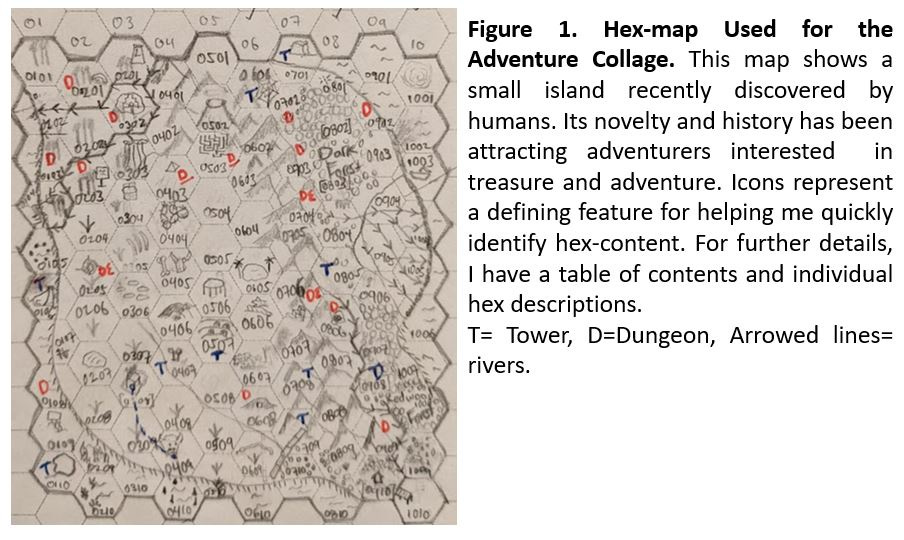An RPG Adventure Collage
Tabletop role-playing games (TTRPGs) provide a wide range of experiences. From embodying a fictional character to exploring fantasy worlds, dissecting mechanics, and creating new content, TTRPGs usually have something for everyone. In my case, I like the creative and experimental process. A hex-crawl is my latest project in which I am trying to integrate individual ideas and pre-made content that I have accumulated throughout the years. A sort of adventure collage, if you will.
Down the Rabbit Hole
One of my joys is reading new TTRPG materials. I enjoy reading many kinds, including full-on campaigns, dungeons, zines, and systems. Each gives me new ideas and perspectives on what is possible at the table. I often imagine how scenarios may play out, what players may do or ask, and how I could implement components in different ways. For example, I was intrigued by the magic casting system from Dungeon Crawl Classics, the roll-under checks and saves from Warhammer RPG, and the inventory management from Mausritter. I also wanted to explore The Tomb of the Serpent Kings, see the machinations of the cult in The Evils of Illmire, and face the Lobnaught (a chitinous shark with lobster claws; yeah cool!), from Planar Compass, among others. Unfortunately, I was accumulating literature faster than I could use it. Thus, I endeavored to integrate them into a single game—to plaster them onto a canvas like a collage of adventures.
The Modularity of Hex-Maps
Enter the hex-map—an excellent way to compartmentalize a geographic location. For me, it simplifies organization, development, and in-game exploration. I reasoned that by creating a hex-map of a region, I could collage all the little parts I had set aside from the literature. This proved to be a good approach. By developing a region of 100 hexes with a few different biomes and inhabitants (factions), I had created my canvas. From there on, I simply looked for organic locations where dungeons, a cult, and lobster-sharks could be found. Within a few months, I had a populated and playable hex-map (Figure 1).
This experience showed me how useful developing a hex-map can be to create a playable world.
· It separated the work into small, manageable chunks. I could spend an hour or two a day working on developing a handful of hexes and feel accomplished every time.
· It facilitated systematically filling an entire map with interactive components. By creating a table, I could go down the list for every hex-column and ensure each hex had a visible feature for navigation purposes, a certain proportion of those a hidden feature, and yet another proportion a secret. Naturally, this process sparked new ideas for other components, such as creatures, structures, and relationships.
· It helped me see and develop relationships with more ease. For example, the placement of the Shays (aggressive Lizard-humanoids in hex [0606]) near a sleeping dragon [0705] helped me develop faction goals for the Shays: indulge the dragon then persuade it to attack another faction. It also facilitated easily moving hexes around to refine relationships.
In all, using a hex-map to develop an adventure collage seemed to facilitate the work and helped me make consistent progress.
Future Directions
I have been running the hex-crawl for over 20 sessions now. Each session has been a perfect opportunity to play test chunks and further develop interconnectedness. For example, a pre-made dungeon that I integrated into the game had players wondering why the dungeon was there and why it functioned as it did. I realized this area needed work and the best way to fix it was by developing that content from scratch. Thus, I have slowly started to phase out pre-made content and replacing it with my own in an effort to build a more cohesive environment. Nevertheless, the adventure collage was an essential process to get me started and quickly build something playable.
If you ever find yourself with more content that you can use, I urge you to develop your own adventure collage. In the meantime, let me know your favorite process for using pre-made content in creative ways.




Comments
Post a Comment